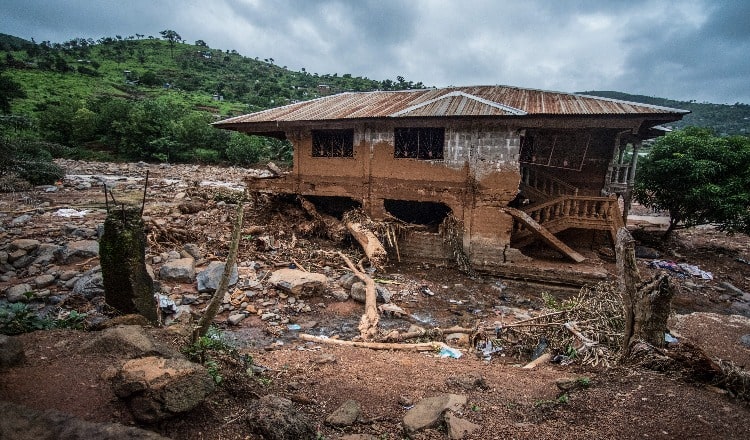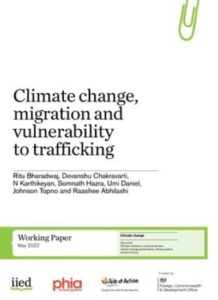Climate change and modern slavery: the nexus that cannot be ignored
8 June 2022
As IIED launches new research demonstrating that climate change not only increases vulnerability but is leading to modern slavery, our CEO Jasmine O'Connor, reflects on the evidence so far and what needs to happen now.

Anti-Slavery International's long history of campaigning to realise freedom from slavery has shown us that slavery thrives where a weak rule of law meets discrimination and poverty.
We know that over 40 million people are currently in modern slavery and that in 2021, the World Bank estimated that more than 200 million people might be forced to migrate due to climate change by 2050.
Climate change and modern slavery are inextricably linked. As climate change threatens the very foundations of our society, we are beginning to see that the heightened vulnerabilities that people experience as they are faced with losing their livelihoods and contemplating migration are making them even more at risk of exploitation.
Since 2021, we have been working with partners and allies to gather evidence of the nexus between modern slavery and climate change. And the evidence is staggering.
Everywhere we have looked – from Peru to Ghana, to Bangladesh, and most recently, India – climate change is forcing migration and leaving those involved highly vulnerable to exploitation.
As the world takes on the challenge of mitigating the risks of our destructive actions, those with intersectional vulnerabilities that are exacerbated by climate change must be considered – and preventing modern slavery must be included in climate action plans at the national, international and institutional levels.
What we know so far
Climate change and environmental degradation exacerbate the drivers of modern slavery. When individuals are forced to migrate or are displaced due to extreme climate disasters, they become particularly vulnerable to modern slavery.
In our first report on climate and modern slavery, we demonstrated that climate change and modern slavery form a vicious circle in which the climate crisis forces many people into work that actively contributes to environmental harm.
Our second report, and the first of our partnership with IIED, showed that:
- In the aftermath of devastating sudden events such as tsunamis and cyclones, local people are vulnerable to traffickers and can be driven into forced labour
- Slow onset climate change events, such as increasing temperatures and unusual rainfall, frequently lead to drought, crop failures and food shortages. Those affected can then be driven to migrate in precarious conditions in search of an alternative livelihood, increasing their vulnerability to forced labour and sexual exploitation, and
- Conflict-affected communities, which struggle with the additional challenges posed by slow onset climate change events, may be forcibly displaced or submit themselves to trafficking which can result in forced and bonded labour.
IIED's latest report, which examines evidence from Jharkhand and Odisha in India – areas which are experiencing climate change in very different ways – found:
- Climate change is acting as a stress multiplier and exacerbating existing vulnerabilities to slavery and exploitation
- Extreme events due to climate change are causing shocks within local communities and affecting livelihoods in ways that can push people to migrate and heighten the risks of slavery and exploitation, and
- There is a lack of resources and infrastructure locally to cope with the extreme climate events that push people to migrate.
This growing body of evidence comes to one conclusion: climate change is causing modern slavery.
What we must do
As the nexus between modern slavery and climate change becomes more apparent, so too does the need to include modern slavery in climate change responses. We want modern slavery to become part of just transition strategies and climate adaptation policies. To achieve this, the connection must be recognised by governments and institutions.
We know we are much stronger together. We need a movement, led by those who live in the affected regions, that can amplify the voices of those who have experienced the links between modern slavery and climate change. And together, we must continue to call for this nexus to be recognised and acted upon.
We want governments to include modern slavery in their national adaptation plans, to reduce the risk of thousands, if not millions, of people finding themselves in modern slavery due to climate change.
Together, as experts in our fields, we will continue to present the facts and add our voices to the discussion on the impact of climate change on human exploitation. We will continue to campaign on this important issue, contributing research and elevating the voices of those affected by this issue to prevent these injustices.
As Anti-Slavery International has done for nearly 200 years, we will continue to shine a light on the root causes of slavery and work to realise freedom from slavery for everyone, everywhere.

Download the report:
Climate change, migration and vulnerability to trafficking
This blog was first published by The International Institute for Environment and Development, 8 June 2022.
This “Eyes on Trafficking” story is reprinted from its original online location.

ABOUT PBJ LEARNING
PBJ Learning is a leading provider of online human trafficking training, focusing on awareness and prevention education. Their interactive Human Trafficking Essentials online course is used worldwide to educate professionals and individuals how to recognize human trafficking and how to respond to potential victims. Learn on any web browser (even your mobile phone) at any time.
More stories like this can be found in your PBJ Learning Knowledge Vault.
EYES ON TRAFFICKING
This “Eyes on Trafficking” story is reprinted from its original online location.
ABOUT PBJ LEARNING
PBJ Learning is a leading provider of online human trafficking training, focusing on awareness and prevention education. Their interactive Human Trafficking Essentials online course is used worldwide to educate professionals and individuals how to recognize human trafficking and how to respond to potential victims. Learn on any web browser (even your mobile phone) at any time.
More stories like this can be found in your PBJ Learning Knowledge Vault.
